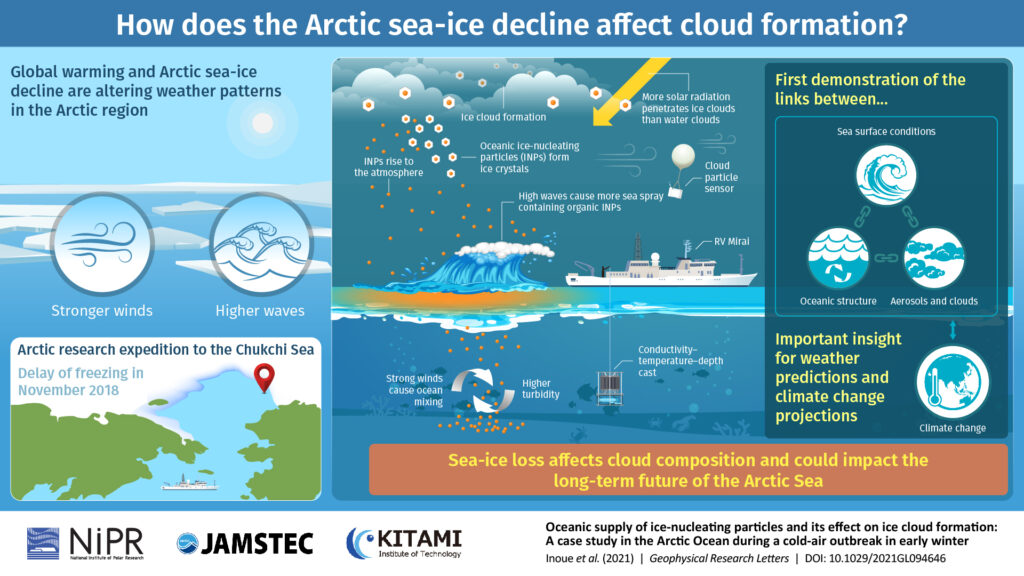A new report from Japan’s National Institute of Polar Research (NIPR) has discovered an important meteorological link between high waves and ice clouds in the Arctic.
Scientists analyzed data from a 2018 research expedition into the Chukchi Sea by NIPR affiliate Dr. Jun Inoue, and set about simultaneously linking oceanic structure, sea surface conditions and aerosol and cloud characteristics to emphasize the role of ‘ice-nucleating particles’ (INPs).
Inoue’s field data from the November 2018 expedition to the Chukchi Sea in the Arctic region was gathered aboard RV Mirai, a Japanese research vessel. Previous studies in the area had revealed that the sea-ice decline in the Arctic led to more frequent active weather systems, stronger wind and taller waves. The research team suspected that these factors could affect cloud formation and composition because crashing waves and strong winds can cause organic particles on the sea surface to become dispersed through the atmosphere in the form of sea spray. Once these suspended organic particles reach a high enough altitude, they act as ‘seeds’ that facilitate the formation of ice crystals, earning them the name of INPs. These ice crystals keep growing by freezing the surrounding water droplets, thereby forming what’s known as ice clouds.
To prove this hypothesis, Inoue and his crew periodically deployed various measurement instruments at key locations in the Chukchi Sea over the course of 12 days. Cloud particle sensors were balloon-launched from the ship to analyze the phase of clouds, ambient aerosols were regularly sampled on board for chemical analysis, and wave height and wind speed measurements were constantly made. Moreover, the researchers conducted turbidity measurements from different depths to clarify the relationship between weather, oceanic conditions and organic matter.
After analyzing all the gathered data, the scientists managed to paint a clearer, evidence-supported view of the situation. Dr Inoue explained that the “Chukchi Sea is relatively shallow, with a mean depth of only 40m. There, a mixed ocean layer develops and taps into the seafloor, which provides a reservoir of INPs that get lifted by turbulent kinetic energy and active biology. Sea spray induced by strong winds and high waves brings these INPs to the atmosphere, promoting the formation of ice clouds”.
According to Inoue, the insight gained from this study could be critical in accurately predicting the effects of global warming on the Arctic. Ice clouds reflect much less shortwave solar radiation than water clouds, and thus the phase of clouds greatly affects the surface heat budget of the polar regions. They may also increase the amount of snowfall, which in turn positively affects sea-ice formation.
“Understanding the relationship between cloud formation and the new sea state originating from the recent Arctic sea-ice decline is critical for skillful weather and sea-ice forecasts, as well as future climate projections,” said Inoue.
Some of the most well-known and feared aspects of climate change are its potential effects on weather patterns and how this could accelerate the melting of natural ice. Research has already proven that the area of sea-ice in the Arctic is rapidly declining, and that temperature and moisture content across the Arctic have changed substantially. Understanding exactly how these changes affect cloud formation in the region is very challenging, and cloud composition and phase are important aspects to consider in predictive numerical models.



